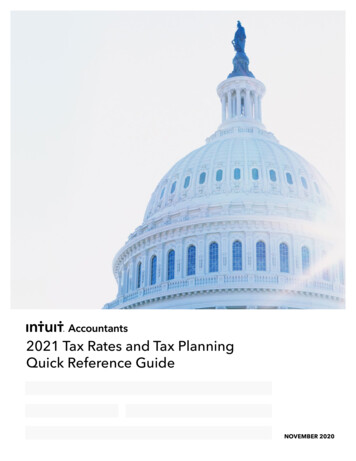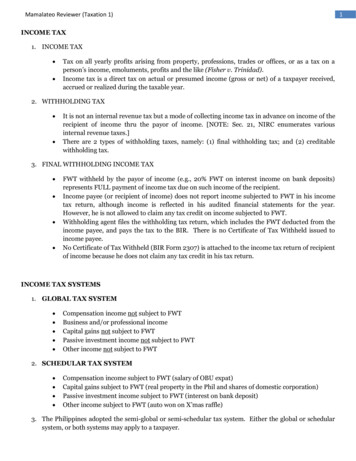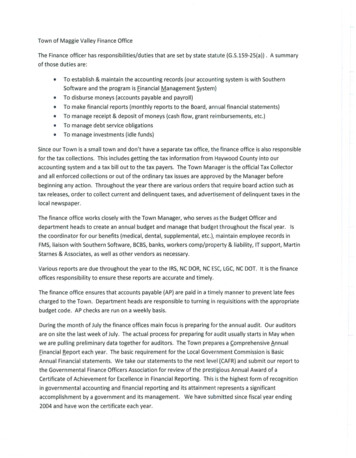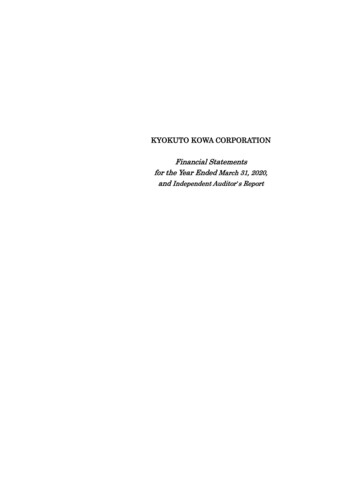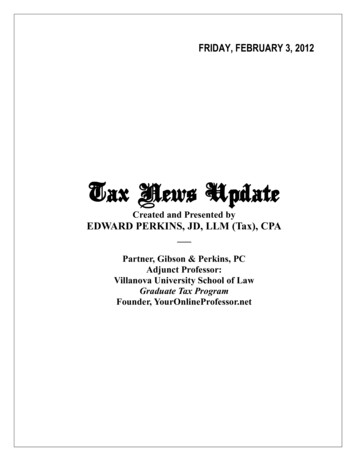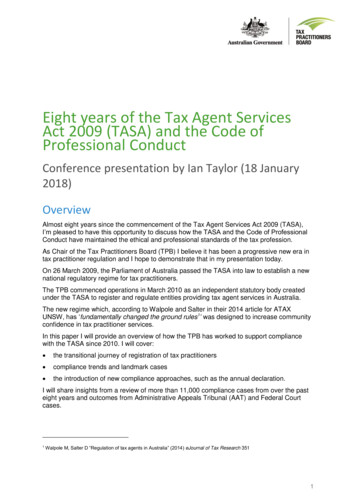
Transcription
Eight years of the Tax Agent ServicesAct 2009 (TASA) and the Code ofProfessional ConductConference presentation by Ian Taylor (18 January2018)OverviewAlmost eight years since the commencement of the Tax Agent Services Act 2009 (TASA),I’m pleased to have this opportunity to discuss how the TASA and the Code of ProfessionalConduct have maintained the ethical and professional standards of the tax profession.As Chair of the Tax Practitioners Board (TPB) I believe it has been a progressive new era intax practitioner regulation and I hope to demonstrate that in my presentation today.On 26 March 2009, the Parliament of Australia passed the TASA into law to establish a newnational regulatory regime for tax practitioners.The TPB commenced operations in March 2010 as an independent statutory body createdunder the TASA to register and regulate entities providing tax agent services in Australia.The new regime which, according to Walpole and Salter in their 2014 article for ATAXUNSW, has ‘fundamentally changed the ground rules1’ was designed to increase communityconfidence in tax practitioner services.In this paper I will provide an overview of how the TPB has worked to support compliancewith the TASA since 2010. I will cover: the transitional journey of registration of tax practitioners compliance trends and landmark cases the introduction of new compliance approaches, such as the annual declaration.I will share insights from a review of more than 11,000 compliance cases from over the pasteight years and outcomes from Administrative Appeals Tribunal (AAT) and Federal Courtcases.1Walpole M, Salter D “Regulation of tax agents in Australia” (2014) eJournal of Tax Research 3511
I will also look at how our strategic focus as a Board has evolved since 2010 and forecastwhat may be in store for both tax practitioners and the TPB in the next eight years.Let me begin this review by providing a summary of the early development of the TPB andsome highlights of the first eight years, with a focus on our compliance strategy during thistime.Establishing the TASA regimeWhile the registration requirements and ongoing obligations were broadly set by the TASAand associated regulations, the TPB’s initial focus was articulating them in a way that couldbe practically applied by the profession.In the TPB’s first annual report of March to June 2010, the inaugural chair of the TPB, DaleBoucher, said: maintaining compliance with the TASA will involve a measured approach, tailored to thecompliance attitudes of those involved, and disciplinary sanctions for breaches whereappropriate. This is aimed at minimising costs for the vast bulk of practitioners who are doingthe right thing.He added:From September 2010, there will be a graduated increase in our compliance focus on taxagents and BAS agents to ensure understanding of new registration obligations and code ofconduct requirements.The TPB was established with 26,000 registered tax practitioners, comprised solely of taxagents who were previously registered with the six state tax agent boards and administeredby the Boards and the Commissioner of Taxation.It was our first task to register these tax agents. In addition, there were still many specialisttax agents operating outside this regulatory framework. One of our first priorities was toidentify, contact and bring these unregistered tax practitioners into the TPB’s regulatorydomain.The TPB also had the considerable challenge of bringing the previously unregulatedbookkeeper profession into the regime as registered BAS agents.This also involved ensuring that all BAS agents were registered with the TPB andsubsequently met all the educational and compliance requirements of registration, as wasthe case for tax agents.Walpole states:‘The inclusion of this latter category of agent was necessary as a result of the introduction ofthe Goods and Services Tax (GST) and consequential reforms which resulted in the need fortaxpayers to complete periodic returns that are not tax returns at the time when the registration of BAS agents was being implemented even fewerbookkeepers [compared to tax agents] would have been members of professional bodies,thus providing further incentive to regulate the ethical framework within which such taxprofessionals operate2.’Over the next few years our focus changed from registration to education and compliance fortax and BAS agents.2Id, page 340-341Australasian Tax Teachers Association Conference 20182
Our journey in developing guidance took time and effort, relying on extensive consultationwith the profession to develop policies that outlined how we would implement the TASA andthe Code and develop practical guidance to help tax practitioners to comply.In 2010, the TPB focused on releasing guidance covering the Code, fitness and propriety,professional indemnity insurance and requirements for courses registered tax agents neededto adequately advise the public on the diverse range of tax issues.In 2011, we finalised our first information sheets, covering the Board’s position onprofessional practice matters ranging from engagement letters, liens over client property aswell as the standard educational requirements for BAS agents. Guidance on situations wheresoftware providers would be proving tax agent services was also finalised.In 2012, we finalised our continuing professional education requirements, as well asguidance on situations where registration would be required for insolvency practitioners,contractors and valuers. We also released our first information sheet on a specific Code item,dealing with item 3, holding client money on trust.This approach continued from onwards 2013, with finalised information sheets on five Codeitems for tax and BAS agents, as well as new information sheets to prepare for theregistration of tax (financial) advisers from 2014.Following a series of carve outs, the registration of financial planners as tax (financial)advisers commenced from 1 July 2014.In recent years, our guidance has evolved to reflect the changing nature of the taxprofession, and the impact of technological improvements and globalisation of the taxsystem.Last year we released our first practice note on cloud computing and the Code, and draftguidance on Code obligations and the practices of outsourcing and offshoring.While the environment is changing and evolving, the role of the TPB and the obligations andresponsibilities of tax practitioners remains the same. The TPB will continue to adapt torecognise changing business practices to help tax practitioners to comply.The impact of the TASA and the Code in setting the ethical and professional standards fortax practitioners has been a significant change that underpins Australia’s tax and supersystems.In their previously cited paper entitled Regulation of tax agents in Australia, Walpole andSalter refer to international research on tax culture:‘the Code is a significant advance on what was in place under the previous Tax AgentRegistration Boards because while those Boards could deregister agents on the grounds thatthey were not a ‘fit and proper person’’, they did not have a Code of Professional Conductagainst which to measure the propriety of a person’s conduct or fitness to act as a tax agent.The new system in Australia has fundamentally changed the ground rules3.’3Ibid 351Australasian Tax Teachers Association Conference 20183
Compliance with the TASA and the CodeNearly eight years on from the start of the TASA, at 30 December 2017, approximately80,000 tax practitioners are now registered with the TPB, including 42,000 tax agents,15,000 BAS agents and 23,000 tax (financial) advisers.Over this time, Australian tax practitioners have mostly responded well to the challenge ofrapidly evolving business practices while meeting their Code obligations.I am pleased to say that more than 98 per cent of tax practitioners are compliant with allaspects of the TASA.Less than two per cent of the behaviour that breaches the TASA and the Code may affectregistration.Trends in tax practitioner complianceThe TPB's compliance approach combines a complaints/referrals process and targetedcompliance activities to protect consumers of tax agent services.The TPB compliance strategy responds to: complaints from the public about the conduct of registered tax practitioners andunregistered entities concerns raised by tax practitioners and their professional associations ATO referrals intelligence from a range of other sources, including the media.We provide assistance and support to address compliance issues for low-risk matters andinvestigate and impose sanctions for high risk cases where the tax practitioner’s behaviour isseen as an unacceptable risk to the public.Complaints received 2010-2017Complaints 2012-132013-142014-152015-162016-17Between 1 July 2010 and 30 June 2017, the TPB received more than 11,000 complaints andreferrals regarding tax practitioners.Australasian Tax Teachers Association Conference 20184
In its first year of operation, the TPB handled more than 2,400 complaints, with more than1,580 (65 per cent) coming from the public.This reflected the growing awareness at the time of the new national regime and the need fortax and BAS agents to be registered with the TPB.Source of complaintsSource of complaints 2010-20171,184 , 11%1,087 , 10%1,041 , 9%Public7,799 , 70%Other tax practitionersATOOtherThe sources of complaints to the TPB have been fairly consistent over the past eight years.On average, around 70 per cent of complaints come from the public each year, followed by afairly even split of complaints from other registered tax practitioners, referrals from the ATOas well as other sources (which includes the TPB’s surveillance and monitoring of media andpractices within the tax profession).Nature of complaintsIn 2012, the TPB implemented a case management system that enabled all compliancematters—including complaints, referrals and proactive work—to be mapped across therelevant provisions of the TASA, such as ‘fit and proper’ matters, alleged breaches of theCode and civil penalty provisions.The system gathers information from a range of sources, to assist in identifying trends innoncompliant behaviour and in planning and allocating resources effectively.Looking back at the nature of the compliance matters the TPB has managed since 2012provides some insights into how the TPB and the tax profession has evolved to meet theethical and professional standards set in the TASA.With eight years behind us we are now able to see how trends have developed incompliance with the TASA, including with the Code, as well as fitness and propriety and civilpenalties.It is important to note that as the TPB has matured, we have developed a betterunderstanding of how the Code applies in special circumstances. As might be expected, thisimproved understanding of the Code and categorisation has led to a refinement of ourprocesses and the way we communicate with tax practitioners.Australasian Tax Teachers Association Conference 20185
Eligibility and fitness & proprietySection 20-5 of the TASA covers eligibility and section 20-15 includes: (a) fit and proper (good fame, integrity and character) (b)(i) certain events that may affect continued registration (b)(ii) undischarged bankruptcy, and (b)(iii) term of imprisonment.Eligibility and fitness & propriety compliance outcomes120Number b)(ii)20-15(b)(iii)Relevant secition of the TASA2012-132013-142014-152015-162016-17There has been a particularly significant drop in compliance matters for both categories ofeligibility (20-50) and fit and proper (20-15 (a)) over the past year. Fit and proper mattersreduced from 109 cases in 2014-15 to 22 in 2016-17.To explain this result, we can point to the establishment of the annual declaration processwhich commenced in January 2016 and has now entered its third year.Apart from an increase in fit and proper matters between 2014 to 2016, there have beenconsistent improvements across this section of the TASA over the past eight years.As you can see, matters primarily related to part (b) of this section of the TASA, are lesscommon.The incidence of individual status of an undischarged bankrupt in the previous five years hasreduced from 55 cases in 2012-13 to one in 2016-17.Matters related to eligibility for registration decreased from 55 cases in 2014-15 to 11 casesin 2016-17.Annual declarationSince January 2016, all registered tax and BAS agents have now completed at least oneannual declaration to demonstrate that they are meeting their ongoing obligations.Australasian Tax Teachers Association Conference 20186
Other than in their year of registration renewal, tax and BAS agents are required to notify theTPB annually that they continue to meet certain ongoing registration requirements.The annual declaration replaced a previous process which required all registeredpractitioners to annually notify the TPB of their professional indemnity (PI) insurance details.The benefits of the annual declaration process include: improved integrity of information (including information publicly available on the TPBRegister) timelier notification of changes in circumstances and ability to promptly address ongoingregistration concerns of some practitioners currency of PI insurance information, compliance with continuing professional education(CPE) requirements and disclosure regarding meeting personal tax obligations identification of practitioners who are not up to date with their own tax obligations.Tax practitioners whose annual declaration is due are sent numerous reminders to lodgetheir annual declaration. Approximately 95 per cent of agents have lodged by the due date.I will cover how non-lodgement of the annual declaration feeds into our complianceprocesses when we look at Part 3 of the TASA, in particular, Code item 14, which is notresponding to requests from the Board.Code of Professional ConductContained in section 30-10 of the TASA, the Code of Professional Conduct establishes a setof ethical and professional standards to be observed by tax practitioners. The Code covers14 principles under five separate categories.To assist tax practitioners to understand their obligations, from its inception the TPB workedin consultation with the tax profession to increase the availability of information and guidancefor tax practitioners on the Code.Since 2010, we have produced a wide range of guidance material including a comprehensiveexplanatory paper and ten information sheets on specific Code items.In addition, the TPB annually publishes a Summary of Penalties publication which usescompliance cases to demonstrate the types of practitioner behaviour that results in a breach.We have developed a growing range of additional communication activities to explainpractical application of the Code, including through our regular TPB eNews, social mediachannels, speaking engagements, face-to-face outreach and our webinar program.Australasian Tax Teachers Association Conference 20187
Honesty and integrityThe first three Code items come under the category of honesty and integrity. Since 2012,around 20 per cent of compliance matters have fallen under this area of the Code. 30-10 (1) You must act honestly and with integrity. 30-10 (2) You must comply with the taxation laws in the conduct of your personalaffairs. 30-10 (3) If:-you receive money or other property from or on behalf of a client, and-you hold the money or other property on trust-you must account to your client for the money or other property.In terms of Code item 1, to determine if a practitioner is acting with honesty and integrity,we take guidance from a range of court decisions that set precedent. This includesconsidering if the practitioner has: acted properly and without deceit acted without intent to gain an improper benefit or advantage for themselves or others genuinely attempted to carry out their duties and obligations imposed by law demonstrated honesty in preparing taxation returns lodged to the ATO failed to make full disclosure of circumstances of matters relevant in assessing theirsuitability to be registered accessed a taxpayer's personal taxation information on the ATO’s Tax Agent Portalwithout authority failed to notify regulatory authorities, such as the ATO and the TPB, of fraudulentactivity that posed a risk to taxpayers and the integrity of the taxation system.Australasian Tax Teachers Association Conference 20188
Code item 1 cases have reduced from 346 in 2012-13 to 43 in 2016-17. A larger number ofmatters were initially attributed to this Code item in the earlier years of the TPB.Experience and the maturing of our compliance processes has resulted in matters onceconsidered an honesty and integrity issue being more relevant other areas of the TASAand the Code.There was a spike in Code item 2 matters (comply with taxation laws in the conduct of yourpersonal affairs) in 2013-14 when the first stage of our Personal tax obligations project wasimplemented.Personal tax obligations projectThe Personal tax obligations project was a joint-initiative of the TPB and the ATO. Theproject evolved between 2012 and 2014 over a number of iterations. Starting in 2012, theATO referred large numbers of agents to the TPB who had:1) outstanding lodgements2) debts with the ATO3) been subject to prosecution by ATO.This project resulted in sanctions ranging from orders to suspensions and termination ofregistration where Code breaches where found. The project also resulted in a number ofcivil penalty matters going to the Federal Court as a result of joint investigations by theTPB and the ATO. Three major cases (Kim, Li and Su) went to the Federal Court in 2014.Case study: Misconduct results in 70,000 penalty and termination ofregistration for Mr Tsu Chien SuThe Federal Court ordered Mr Tsu Chien Su (a previously registered tax agent) topay a 70,000 penalty for committing 50 breaches of the TASA by recklesslymaking false statements to the Commissioner of Taxation, and causing loss ofrevenue to the Commonwealth and personal gain to the agent.Mr Su admitted to 50 contraventions of the TASA, with 25 of the 50 relating to falseinformation in returns derived from false payment summaries, and the other 25contraventions relating to the false tax agent certificate contained in each return.This was the first time the Federal Court imposed a pecuniary penalty on aregistered agent for contraventions of the TASA. Among other considerations, inimposing the 70,000 penalty the Federal Court made allowances for the fact thatMr Su had admitted to the contraventions early in the process and had showncontrition.Following a finding by the TPB that Mr Su had knowingly breached the Code, theTPB terminated his registration as a tax agent in August 2013, imposing a period ofthree years before he could re-apply for registration. Mr Su appealed this decisionto the AAT. The AAT affirmed the TPB’s decision.The second increase in compliance matters relating to Code item 2 in 2016-17 occurred asa result of the annual declaration process.Australasian Tax Teachers Association Conference 20189
Annual declaration projectThe start of the annual declaration requirement for tax and BAS agents in January 2016was a significant event for the TPB.The annual declaration was part of a concerted effort to encourage ongoing interactionbetween the TPB and registered tax practitioners to ensure that all tax practitionerscontinued to meet the ongoing registration requirements, including having PI insurance.It represents a substantial change from past requirements and is crucial to maintaining theethical and professional standards of tax practitioners.Initially, most tax practitioner interaction with the TPB was limited to their initial registrationfollowed by their renewal every three years. The annual declaration provides a simple,annual ‘check-up’ so to speak, ensuring a regular focus by practitioners that they aremeeting their ongoing registration obligations.As part of the annual declaration process, the TPB wanted to ensure that agents who hadanswered questions in the annual declaration form a certain way that did not meetrequirements were not inappropriately penalised.With respect to Code item 2, in most cases a phone call to the practitioner addressedthese issues. For example, while a practitioner may indicate in their annual declarationthey had overdue personal tax obligations, arrangements may be in place to manage thiswith the ATO.Since January 2016, of over 70,000 annual declarations lodged, the TPB has resolved 305cases through this method.Independence 30-10 (4) You must act lawfully in the best interests of your client. 30-10 (5) You must have in place adequate arrangements for the management ofconflicts of interest that may arise in relation to the activities that you undertake in thecapacity of a registered tax agent, BAS agent or tax (financial) adviser.The second category of the Code, independence, covers two items that relate to apractitioner’s responsibility to achieve balance – in serving their clients and complying withthe law, and managing the conflicts that will arise in the course of providing tax agentservices.Australasian Tax Teachers Association Conference 201810
Since 2012, 11 per cent of Code compliance matters have fallen under this area of theCode.Code item 4 (You must act in the best interests of your client) matters reduced from 277cases in 2013-14 to 66 in 2016-17. In 2013-14, a larger number of matters were attributedto this Code item, and experience has shown us that these were more relevant to otherareas of the TASA and the Code in later years.While the number of matters falling under Code item 4 have decreased since 2013-14, it isa growing area of focus with the tax practitioner community facing scrutiny from multipleangles particularly in relation to acting ‘lawfully’ in the best interests of clients.From another perspective, the Black Economy Taskforce has been established by theTreasury to consider whole-of-government policy responses to people who operate outsidethe tax and regulatory system or who are known to the authorities but do not correctlyreport their tax obligations.They have recently recommended that greater attention be paid to sanctioning unethicalagents involved in the black economy, and the TPB’s role in facilitating this.The Taskforce’s message will be clear – it will be no longer acceptable for tax practitionersto turn a blind eye to the illegality of their clients’ tax affairs.Code item 5 (You must have in place adequate arrangements for the management ofconflicts of interest) has seen a very small number of compliance matters since 2012 –only 27 overall – but it is nonetheless a key focus for the TPB’s guidance and education.Our information sheet on managing conflicts of interest for tax and BAS agents wasfinalised in 2014, with an information sheet for tax (financial) advisers published in 2016.We are seeing an increase in cases involving matrimonial disputes involving clients ofpractitioners and a consequent lack of authorities to act from some parties.Confidentiality 30-10 (6) Unless you have a legal duty to do so, you must not disclose any informationrelating to a client’s affairs to a third party without your client’s permission.Code item 6 is another item in the Code that attracts only a small number of matters where it is the primary issue.Australasian Tax Teachers Association Conference 201811
Since 2012, only 0.5 per cent of Code compliance matters have fallen under this area ofthe Code. We may have more matters than the statistics might suggest for this Code item,but the primary assessment identifies other Code items that can predominate.Other relevant considerations that come out of this Code item include the importance of aletter of engagement, understanding mutual obligations, cloud and outsourcing andoffshoring.A specific information sheet on Code item 6 was finalised in 2014 for tax and BAS agents,with an information sheet for tax (financial) advisers being finalised in 2017.The TPB has seen an evolution in the way the guidance applies to emerging issues facingtax practitioners, with a number of Code items being relevant to a specific practice orissue.A recent example is Code item 6 covered in guidance released on cloud computing andoutsourcing and offshoring, which draws in a number of Code items related to the topic.Competence 30-10(7) You must ensure that a tax agent service that you provide, or that is providedon your behalf, is provided competently. 30-10(8) You must maintain knowledge and skills relevant to the tax agent servicesthat you provide. 30-10(9) You must take reasonable care in ascertaining a client’s state of affairs, to theextent that ascertaining the state of those affairs is relevant to a statement you aremaking or a thing you are doing on behalf of a client. 30-10(10) You must take reasonable care to ensure that taxation laws are appliedcorrectly to the circumstances in relation to which you are providing advice to a clientThe Code items under the category of competence have accounted for 14 per cent ofCode matters the TPB has dealt with since 2012.Code item 7 (You must ensure that a tax agent service that you provide or that is providedon your behalf, is provided competently) matters reduced from 302 cases in 2014-15 to 48in 2016-17.Australasian Tax Teachers Association Conference 201812
Again, we can attribute the reduction in matters under this Code item to experience and abetter understanding of how complaints related to competence are better related to otherCode items.Code items 8-10 matters are minimal. In 2016-17 there were a several of matters relatedto Code item 8 arising out of the annual declaration process, where practitioners had failedto meet our CPE requirements.The annual declaration provides the opportunity to engage with these practitioners to seekfurther information and to support them to understand and meet the ongoing CPErequirements.Other responsibilities 30-10 (11) You must not knowingly obstruct the proper administration of the taxationlaws. 30-10(12) You must advise your client of the client’s rights and obligations under thetaxation laws that are materially related to the tax agent services you provide. 30-10(13) You must maintain the professional indemnity insurance that the Boardrequires you to maintain. 30-10(14) You must respond to requests and directions from the Board in a timely,responsible and reasonable manner.It is encouraging to see very few matters have been investigated that relate to Code items11 and 12 – the proper administration of and advising clients of their rights under taxationlaws. As fundamental elements of the role of a tax practitioner, they reflect the highstandards of professionalism within the tax profession.Code items 13 and 14 together have accounted for 55 per cent of all Code mattersconsidered by the TPB since 2012.Code item 13 (maintain PI insurance that meets the Board’s requirements) reduced from899 cases in 2013-14 to five in 2016-17.Australasian Tax Teachers Association Conference 201813
From 1 July 2011, registered tax and BAS agents had to maintain PI insurance cover, andnotify the TPB of the details of their insurance cover arrangements.At 1 July 2012, around 10 per cent of registered tax and BAS agents had failed to notifyus. By 30 June 2013, this figure had fallen to less than three per cent.The TPB took a number of steps to achieve this improvement in the notification rate.The TPB commenced a compliance project targeting those agents who had not told usabout their PI insurance, completing 813 investigations during 2012–13 into possiblebreaches of the Code.As a result, the Board made decisions to suspend the registration of 50 agents andordered them to obtain PI insurance cover that met the TPB’s requirements.From 30 June 2013, following amendments to the TASA, it has become a legislativeregistration requirement that all registered tax and BAS agents must demonstrate that theymaintain, or will be able to maintain, PI insurance that meets the TPB’s requirements. Italso remains a requirement under the Code.Following the introduction of the annual declaration, 99 per cent of those registered taxand BAS agents who were required to complete their annual declaration, have notified theTPB that they meet the TPB’s professional indemnity insurance requirement.However, the annual declaration has also resulted in an increase in Code item 14 matters(You must respond to requests and directions from the Board in a timely, responsible andreasonable manner).Of the 2,244 matters relating to a possible breach of the Code investigated in 2016-17,1,895 (84 per cent) related to Code item 14. Most of these matters relate to failure torespond to requests from the Board to complete the annual declaration by the due date.Where practitioners fail to complete their annual declaration on time, we contact them andprovide a final opportunity for them to complete it before an investigation commences.These instances generally result in lodgement without the need for an investigation butunfortunately some disregard these opportunities which ultimately leads to termination ofregistration.Australasian Tax Teachers Association Conference 201814
Civil penaltiesCivil penalties200180160Number 13-142014-1550-202015-1650-2550-302016-17Civil penalties are pecuniary penalties imposed by courts exercising a civil rather thancriminal jurisdiction. The civil penalty provisions in the TASA apply to: unregistered entities providing or advertising tax agent services while unregistered, orrepresenting themselves as registered when they are not respectively (50-5, 50-10 and50-15) registered entities making false or misleading statements, employing or
Australasian Tax Teachers Association Conference 2018 4 Compliance with the TASA and the Code Nearly eight years on from the start of the TASA, at 30 December 2017, approximately 80,000 tax practitioners are now registered with the TPB, including 42,000 tax agent



